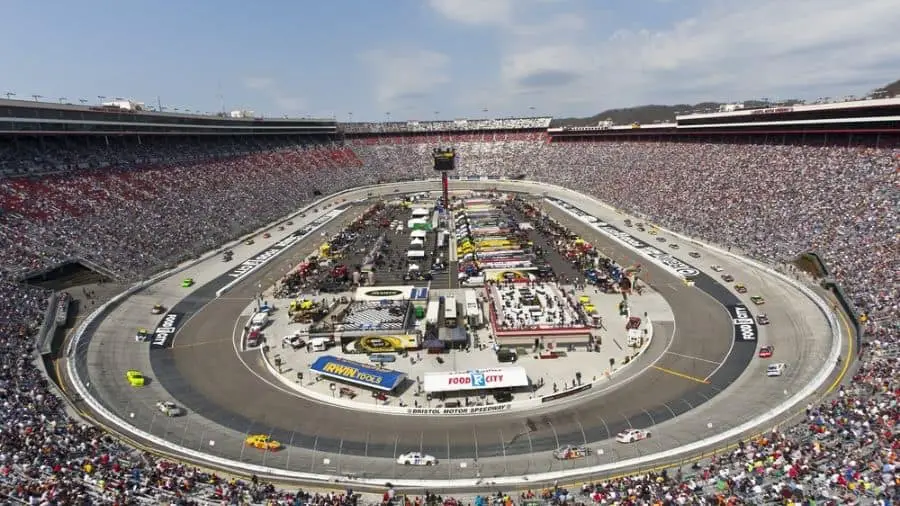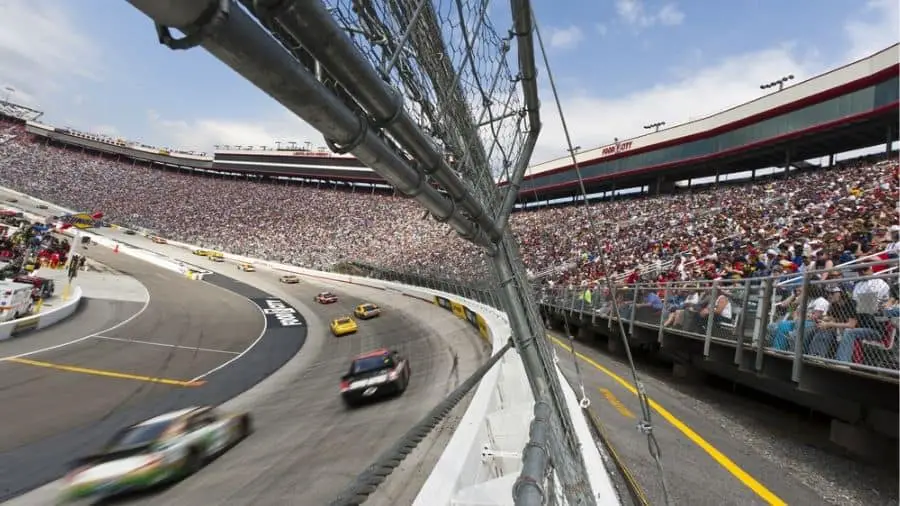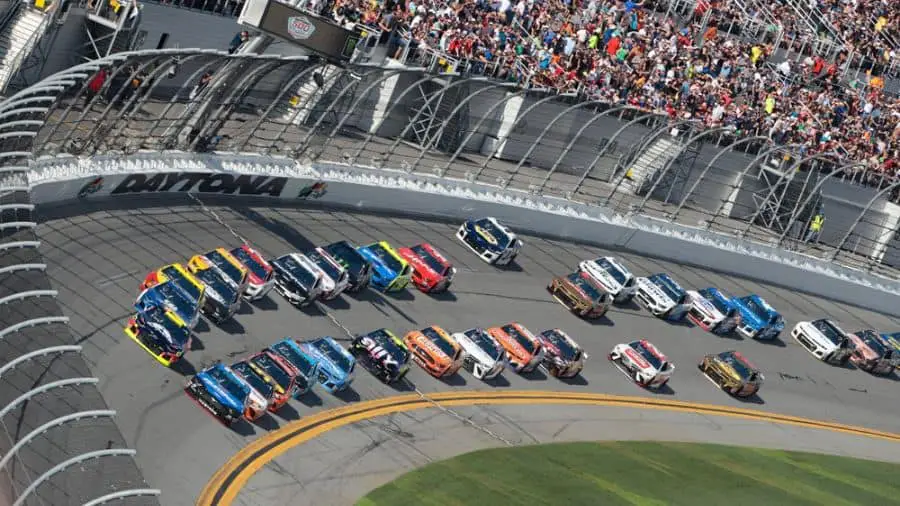
In sports, the playing surface is usually kept consistent. In football, the field is 100 yards. The distance from a pitching mound to the plate in Major League Baseball is always 60 feet and 6 inches. It has to be consistent, down to the inch. So you might be wondering if the same applies to NASCAR and if all the race tracks are in fact the same.
No, not all NASCAR tracks are the same. They vary throughout the circuit and can range from a half mile to the 2.66 mile Talladega. Even Short Tracks are all different, with any track under 1 mile given the name. A Superspeedway is anything above 2 miles. Even within these classifications, all of the tracks have different curves and banking.
NASCAR tracks come in all shapes and sizes, and despite some strong similarities between some, each track has its own characteristics. in this article, we’ll go into great detail to give you all the inside knowledge, so keep reading to find out more about the anatomy of a NASCAR track.
Table of Contents
Are All NASCAR Tracks the Same?
No, they aren’t. Even if they have the same distance, they have different banking, asphalt and road conditions, making every race different.
Even though they are all oval, the shape of the oval is completely different. Some tracks have the same turn at each end, while others have 4 turns and yet others are egg-shaped. Even if they have the same shape, the banking of the turns can be completely different.
So, let’s start with distance.
| Track | Distance |
| Martinsville Speedway | 0.526 miles |
| Bristol Motor Speedway | 0.533 miles |
| Richmond Raceway | 0.75 miles |
| Dover International Speedway | 1 mile |
| Phoenix Raceway | 1 mile |
| New Hampshire Motor Speedway | 1.058 miles |
| Darlington Raceway | 1.37 miles |
| Charlotte Motor Speedway | 1.5 miles |
| Chigacoland Speedway | 1.5 miles |
| Homestead-Miami Speedway | 1.5 miles |
| Kansas Speedway | 1.5 miles |
| Las Vegas Motor Speedway | 1.5 miles |
| Texas Motor Speedway | 1.5 miles |
| Kentucky Speedway | 1.5 miles |
| Atlanta Motor Speedway | 1.54 miles |
| Sonoma Raceway | 1.99 miles |
| Auto Club Speedway | 2 miles |
| Michigan International Speedway | 2 miles |
| Charlotte Motor Speedway Roval | 2.28 miles |
| Watkins Glen International | 2.45 miles |
| Daytona International Speedway | 2.5 miles |
| Indianapolis Motor Speedway | 2.5 miles |
| Pocono Raceway | 2.5 miles |
| Talladega Superspeedway | 2.66 miles |
As you can see, there’s a great disparity in track distance on the circuit. Any track that has a distance under 1 mile is given the name Short Track (Martinsville to Phoenix). Anything above 2 miles (3.2km) distance is called a Superspeedway. There are six active Superspeedways in the United States, the most famous being Indianapolis Motor Speedway and Daytona International Speedway, both 2.5 miles (4.0 km) long.
All tracks are made of asphalt, that’s really the only consistent factor between them all. And that used to not be the case, as some of NASCAR tracks were dirt in the beginning.
The longer tracks now require restrictor plates on the engine to slow them down. This is due to physics catching up with the top speed of cars. The faster the car goes; the more downward force is needed to keep the tires on the track. If the car goes too fast for the track, then it can become airborne and could potentially fly into the grandstands.
Restrictor plates are more for the safety of the fans than for the safety of the drivers. Slower speeds result in more crashes, as drivers are always bumping for space. So, restrictor plates are to stop the NASCAR cars from leaving the track and hurting the spectators, not to keep the drivers safer on the track.
That being said, the fastest a NASCAR car has ever gone on a track is 214 mph in 1987 before restrictor plates were made mandatory in 1988. This was on Talladega, the longest track with the longest straightaway.
Why are NASCAR Tracks Oval?
Physics. That’s the short answer.
The long answer gets a little more in-depth and needs a little bit more understanding of some scientific terms, bare with me.
Centripetal Force: The inward force that acts on an object traveling in a circular path directed toward the center around where the object is moving, necessary to keep the object in motion around the circular path
Centrifugal Force: The apparent force felt when moving along a circular path that directs to the outside
Okay, I get it. What does this mean? It’s all about a frame of reference. When you’re driving a car, the driver who is in the front seat feels an outward force when the car goes around a turn. The car itself is being forced inward by centrifugal force.
The whole point of auto racing is to see who can go the fastest. Now that we have restrictor plates on the engine that limits the speed at which cars can go in NASCAR, the entire thing is about who can do a distance first. Straightaways are always faster than a curved or circular track.
If NASCAR cars only drove in a straight line for 200 miles, arguably it wouldn’t be as much fun to watch. Racers would either see the beginning or the end, and it’s not as thou 100,000 people would line the racetrack to watch a split second that the cars race by at 200 mph. So, for the good of the sport, the track has to be circular in order for people to watch.
Why an Oval Track Instead of a Circular Track?
For clarification, a straightaway is exactly what it sounds like, a straightaway is “straight”. This section of the track is meant to let drivers really push the speed limits of their cars. It’s in every NASCAR track and its where the start/finish line is located. The straightaway is the stretch that is the fastest.
So straightaways are faster than a circle. Remember those forces from above? The centripetal force acts on a vehicle going around a circle, meaning that there is an external force acting on the car that the wheels, engine and driver have to fight against to stay on the track. This slows the car down, as all the force is not going in the straight direction.
So, we need a circular track that spectators can watch the whole race. But straightaways are faster than a circle. And the whole point of auto racing is to go fast…
Enter the oval. Ovals give straightaways to increase the speed of the race, it allows spectators to watch the entirety of the race, and it allows the minimum time going around a curve to reduce centrifugal force.
Why are NASCAR Tracks Banked?

Physics! Again, with the physics. It always seems to have something to do with science…
So, NASCAR is about going fast. That’s the whole point of the sport. Breakneck speeds and having people watch the action.
A straight track would allow for the fastest races. But this is not feasible in NASCAR. So we have an oval track to add straightaways and add speed.
In a turn, the centrifugal force acts on the car, along with the downward force of gravity. This requires the car to slow down to make the turn. If they didn’t, then the forces on the car would be enough to break the friction of the tires. This would make the car slide (dangerous), or send the car airborne into the stands (very dangerous).
We need a way to make the track fast, but the speed that the drivers get on the straightaway would be way too fast to negotiate a flat curve. The drivers would not be able to race fast on a flat track. It would be way too dangerous for everyone involved. A bank is added to the track in order to keep the race fast and safe.
The bank shifts the force vector of the gravitational pull. It’s no longer straight down, but at the angle of the track itself. The centrifugal force still acts towards the inside.
So, with the bank in the track, the vector still points down which keeps the tires of the NASCAR car on the asphalt. Tracks have professionals come in at the designing stage in order to keep the banks and straightaways optimal for speed. A fast track is a fun track.
Are All NASCAR Tracks Left Turns?
Besides a couple of road courses (Charlotte Motor Speedway and Watkins Glen International), most NASCAR tracks are ovals where the drivers go counterclockwise, therefore left turns.
Why left? What would happen if they went right around the track once? Is there any purpose to left turns instead of right, other than it’s how its always been done?
The driver in NASCAR sits on the left side of the car (as opposed to the right side in Europe). Therefore, there’s extra weight in the front left of the NASCAR car. It’s always 200 lbs extra, as each driver is weighed before the race and extra weight is added to the car to make the driver weight exactly 200 lbs. The inside of the car being the heaviest is important, as it counteracts the centripetal force on the car.
When something is heavier on the inside of a turn, the gravitational force is heavier on that side of the car, meaning that the force vector is larger on the inside of the car. This allows for more traction in the NASCAR. More traction means that there’s more speed available in the turn.
Another reason why they stay exclusively counterclockwise when they run NASCAR is that it gives the driver a better view of the track and the cars. The driver has the ability to see four cars in front of them and keep track of what’s going on inside by the small mirror in their roll cage.
If the turns were right turns, the driver would lose the inside of the track in the apex of the turn, greatly decreasing visibility and forcing the drivers to take the turn higher up on the track.
The last reason is actually a throwback to the early days of NASCAR and its predecessor: horse racing.
When America defeated the British, they began racing horses the opposite direction of the British as a “middle finger” to their previous reign. This caused the driver to be put on the left side of vehicles in America, but on the right side of vehicles in Europe, a practice that still holds to this day. Races are clockwise in Europe and counterclockwise in America due to how they raced horses back in the day.

Where are the NASCAR Tracks Located?
This varies by track. Some are out of city limits, some in small towns and others in large centers.
| Track | Location |
| Martinsville Speedway | Ridgeway, Virginia |
| Bristol Motor Speedway | Bristol, Tennessee |
| Richmond Raceway | Henrico County, Virginia |
| Dover International Speedway | Dover, Delaware |
| Phoenix Raceway | Avondale, Arizona |
| New Hampshire Motor Speedway | Loudon, New Hampshire |
| Darlington Raceway | Darlington, South Carolina |
| Charlotte Motor Speedway | Concord, North Carolina |
| Chigacoland Speedway | Joilet, Illinois |
| Homestead-Miami Speedway | Homestead, Florida |
| Kansas Speedway | Kansas City, Kansas |
| Las Vegas Motor Speedway | Clark County, Nevada |
| Texas Motor Speedway | Fort Worth, Texas |
| Kentucky Speedway | Sparta, Kentucky |
| Atlanta Motor Speedway | Hampton, Georgia |
| Sonoma Raceway | Sonoma, California |
| Auto Club Speedway | Fontana, California |
| Michigan International Speedway | Brooklyn, Michigan |
| Charlotte Motor Speedway Roval | Concord, North Carolina |
| Watkins Glen International | Watkins Glen, New York |
| Daytona International Speedway | Daytona Beach, Florida |
| Indianapolis Motor Speedway | Speedway, Indiana |
| Pocono Raceway | Long Pond, Pennsylvania |
| Talladega Superspeedway | Talladega, Alabama |
Each track in NASCAR has the ability to seat over 40,000 people, with the smallest being Watkins Glen at 41,000 and the largest Indianapolis Motor Speedway at a whopping 257,000. The seating capacity of these tracks are larger than many of the towns and counties that they are located in. Some have more than one race that takes place, others have a single race a season. Others have lights, and some don’t, so nighttime races depend on the track.
Are There any New NASCAR Tracks Being Built?
Agreements are coming to an end at the end of the 2020 race season, meaning there could be different tracks in future seasons. Many tracks are already built, but they currently don’t have NASCAR races on the schedule.
- Iowa Speedway
- At almost a mile long, it still constitutes a short track. It currently has the Xfinity and the Truck Series, so seeing NASCAR there in the future isn’t a far stretch. It has deep banks on the curves, allowing it to be a fast track with lots of photo finishes and side by side racing.
- Road America
- This track was last used for NASCAR in 1956, is over four miles long and is currently used by the Xfinity series. Located in Elkhart Lake, Wisconsin, this race is already popular in the Xfinity series.
- Circuits of the Americas
- Currently used as the F1 U.S. Grand Pre location, this track has 20 turns and is a challenge. Most road tracks don’t have this many turns, but NASCAR fans are looking for a change and this track in Austin, Texas.
- Rockingham Speedway
- Located in the heart of NASCAR, this track is in Rockingham, North Carolina and considered a short track at just over 1 mile long. It last hosted NASCAR in 2004
As of right now, there’s no new tracks being built in America exclusively for NASCAR. If NASCAR was to expand, it would be to already existing tracks that currently aren’t used in NASCAR. Many tracks have been used before and NASCAR has deals with tracks on how many races are scheduled every year. Negotiations take place between NASCAR and the track owners and they come to a deal for races and number of seasons that they come back for.
NASCAR is first and foremost a business. If a race doesn’t prove to be entertaining enough or profitable enough, it will be removed from the circuit. Races move every year and tracks are used at different times of the season. Each season looks different, bringing about a seasonal change that teams and fans can look forward to.
NASCAR is on the lookout for new and exciting ways to entice viewers and fans to come to races. New tracks are always on the table, including the possibility of adding road races to the mix to liven it up. That, along with going to untapped markets and new race tracks may be the change NASCAR is looking for.
With restrictor plates being mandatory since 1988, an increase in speed isn’t on the cards to make NASCAR more popular. The cars are now too fast for the tracks themselves, and an increase in danger isn’t the answer. NASCAR fans are demanding more risk, and to keep the fans and drivers safe, risk is inherent in new tracks.
